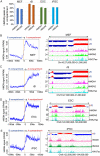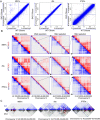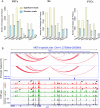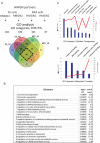Multiple epigenetic factors co-localize with HMGN proteins in A-compartment chromatin
- PMID: 35761366
- PMCID: PMC9235084
- DOI: 10.1186/s13072-022-00457-4
Multiple epigenetic factors co-localize with HMGN proteins in A-compartment chromatin
Abstract
Background: Nucleosomal binding proteins, HMGN, is a family of chromatin architectural proteins that are expressed in all vertebrate nuclei. Although previous studies have discovered that HMGN proteins have important roles in gene regulation and chromatin accessibility, whether and how HMGN proteins affect higher order chromatin status remains unknown.
Results: We examined the roles that HMGN1 and HMGN2 proteins play in higher order chromatin structures in three different cell types. We interrogated data generated in situ, using several techniques, including Hi-C, Promoter Capture Hi-C, ChIP-seq, and ChIP-MS. Our results show that HMGN proteins occupy the A compartment in the 3D nucleus space. In particular, HMGN proteins occupy genomic regions involved in cell-type-specific long-range promoter-enhancer interactions. Interestingly, depletion of HMGN proteins in the three different cell types does not cause structural changes in higher order chromatin, i.e., in topologically associated domains (TADs) and in A/B compartment scores. Using ChIP-seq combined with mass spectrometry, we discovered protein partners that are directly associated with or neighbors of HMGNs on nucleosomes.
Conclusions: We determined how HMGN chromatin architectural proteins are positioned within a 3D nucleus space, including the identification of their binding partners in mononucleosomes. Our research indicates that HMGN proteins localize to active chromatin compartments but do not have major effects on 3D higher order chromatin structure and that their binding to chromatin is not dependent on specific protein partners.
Keywords: Chromatin structure; HMGN; Hi–C; Mass spectrometry.
© 2022. This is a U.S. Government work and not under copyright protection in the US; foreign copyright protection may apply.
Conflict of interest statement
The authors declare that they have no competing interests.
Figures





Similar articles
-
H3K27ac nucleosomes facilitate HMGN localization at regulatory sites to modulate chromatin binding of transcription factors.Commun Biol. 2022 Feb 23;5(1):159. doi: 10.1038/s42003-022-03099-0. Commun Biol. 2022. PMID: 35197580 Free PMC article.
-
HMGN proteins modulate chromatin regulatory sites and gene expression during activation of naïve B cells.Nucleic Acids Res. 2016 Sep 6;44(15):7144-58. doi: 10.1093/nar/gkw323. Epub 2016 Apr 25. Nucleic Acids Res. 2016. PMID: 27112571 Free PMC article.
-
Epigenetic regulation of REX1 expression and chromatin binding specificity by HMGNs.Nucleic Acids Res. 2019 May 21;47(9):4449-4461. doi: 10.1093/nar/gkz161. Nucleic Acids Res. 2019. PMID: 30838422 Free PMC article.
-
Regulation of chromatin structure and function by HMGN proteins.Biochim Biophys Acta. 2010 Jan-Feb;1799(1-2):62-8. doi: 10.1016/j.bbagrm.2009.11.016. Epub 2009 Nov 27. Biochim Biophys Acta. 2010. PMID: 19948260 Free PMC article. Review.
-
HMGN dynamics and chromatin function.Biochem Cell Biol. 2003 Jun;81(3):113-22. doi: 10.1139/o03-040. Biochem Cell Biol. 2003. PMID: 12897844 Review.
Cited by
-
Epigenetic Regulation of Ameloblast Differentiation by HMGN Proteins.J Dent Res. 2024 Jan;103(1):51-61. doi: 10.1177/00220345231202468. Epub 2023 Nov 10. J Dent Res. 2024. PMID: 37950483 Free PMC article.
-
Epigenetic regulation of white adipose tissue plasticity and energy metabolism by nucleosome binding HMGN proteins.Nat Commun. 2022 Nov 26;13(1):7303. doi: 10.1038/s41467-022-34964-5. Nat Commun. 2022. PMID: 36435799 Free PMC article.
-
The role of high mobility group proteins in cellular senescence mechanisms.Front Aging. 2024 Oct 23;5:1486281. doi: 10.3389/fragi.2024.1486281. eCollection 2024. Front Aging. 2024. PMID: 39507236 Free PMC article. Review.
-
Chromosome compartmentalization: causes, changes, consequences, and conundrums.Trends Cell Biol. 2024 Sep;34(9):707-727. doi: 10.1016/j.tcb.2024.01.009. Epub 2024 Feb 22. Trends Cell Biol. 2024. PMID: 38395734 Free PMC article. Review.
-
Pan-cancer Multi-omics Analysis Reveals HMGN1 as a Potential Prognostic and Immune Infiltration-associated Biomarker.Curr Med Chem. 2025;32(12):2440-2459. doi: 10.2174/0109298673268718231122103638. Curr Med Chem. 2025. PMID: 38310387 Free PMC article.
References
Publication types
MeSH terms
Substances
LinkOut - more resources
Full Text Sources
Miscellaneous

